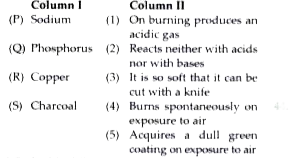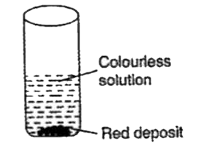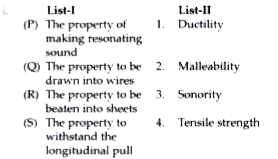EXERCISE (Match the Following) from MTG IIT JEE FOUNDATION MATERIALS : METALS AND NON-METALS for Class 8
| Class 8 | CHEMISTRY |
| Chapter | MATERIALS : METALS AND NON-METALS |
| MTG IIT JEE FOUNDATION | EXERCISE (Match the Following) |
| Medium | English |
| Academic Year | 2023-2024 |
Question 49
Some materials like magnesium ribbon, aluminium foil, copperr wire and charcoal (powder) were taken in different test tubes labelled as P, Q, R and S. 5 mL of dilute hydrochloric acid was added to each test tube. When a burning matchstick is brought near the mouth of each test tube, in which cases pop sound would be heard ?View SolutionQuestion 66
The decay of metals by atmospheric oxygen and moisture is called corrosion. Few metals do not react with atmospheric gases and water and do not undergo corrosion, while others develop a dull layer on them or a coloured layer to spoil their shiny appearance or turn black or are converted into powder. few elements, on the other hand are protected due to presence of this dull layer of oxide on them.
Q. Aluminium does not react readily with air or water becauseView SolutionQuestion 67
The decay of metals by atmospheric oxygen and moisture is called corrosion. Few metals do not react with atmospheric gases and water and do not undergo corrosion, while others develop a dull layer on them or a coloured layer to spoil their shiny appearance or turn black or are converted into powder. few elements, on the other hand are protected due to presence of this dull layer of oxide on them.
Q. Iron reacts with air in presence of water and forms a brown powder which is called rust. chemically rust isView SolutionQuestion 68
The decay of metals by atmospheric oxygen and moisture is called corrosion. Few metals do not react with atmospheric gases and water and do not undergo corrosion, while others develop a dull layer on them or a coloured layer to spoil their shiny appearance or turn black or are converted into powder. few elements, on the other hand are protected due to presence of this dull layer of oxide on them.
Q. Silver metal on exposure to air for a long time becomes black in colour. what is the reason behind it ?View SolutionQuestion 69
The decay of metals by atmospheric oxygen and moisture is called corrosion. Few metals do not react with atmospheric gases and water and do not undergo corrosion, while others develop a dull layer on them or a coloured layer to spoil their shiny appearance or turn black or are converted into powder. few elements, on the other hand are protected due to presence of this dull layer of oxide on them.
Q. The green layer developed on copper on exposure to air is due toView SolutionQuestion 70
Certain metals have the capacity to displace some metals from their salt solutions. These reactions are known as metal displacement reactions. A metal placed higher in activity series can displace the metal occupying lower position from aqueous solution of its salt or a more reactive metal can displace less reactive metal from its salt solution.
Q. If a zinc rod is dipped in copper sulphate solution, following changes will be noticed. mark the correct observations.
(i) Zinc rod slowly loses its weight.
(ii) Copper settles at the bottom of the beaker.
(iii) Blue colour of copper sulphate disappears.View SolutionQuestion 71
Certain metals have the capacity to displace some metals from their salt solutions. These reactions are known as metal displacement reactions. A metal placed higher in activity series can displace the metal occupying lower position from aqueous solution of its salt or a more reactive metal can displace less reactive metal from its salt solution.
Q. Take aqueous solution of copper sulphate in one test tube and ferrous sulphate in another test tube. dip an iron nail in copper sulphate and copper wire in ferrous sulphate solution. mark the correct observation.View SolutionQuestion 72
Certain metals have the capacity to displace some metals from their salt solutions. These reactions are known as metal displacement reactions. A metal placed higher in activity series can displace the metal occupying lower position from aqueous solution of its salt or a more reactive metal can displace less reactive metal from its salt solution.
Q. The above observations show thatView SolutionQuestion 73
Certain metals have the capacity to displace some metals from their salt solutions. These reactions are known as metal displacement reactions. A metal placed higher in activity series can displace the metal occupying lower position from aqueous solution of its salt or a more reactive metal can displace less reactive metal from its salt solution.
Q. Displacement reactions are shown byView SolutionQuestion 74
Metals and non-metals react with oxygen to give oxide are basic in nature while oxides formed by non-metals are acidic in nature. The nature of oxides can be determiend by testing the aqueous solution of oxide with litmus paper.
Q. The oxides of non-metals are acidic oxides because they dissolve in water to give ____View SolutionQuestion 75
Metals and non-metals react with oxygen to give oxide are basic in nature while oxides formed by non-metals are acidic in nature. The nature of oxides can be determiend by testing the aqueous solution of oxide with litmus paper.
Q. Phosphorus is burnt in air to give phosphorus pentoxide. it is dissolved in water and tested with litmus paper. mark the correct observation.View SolutionQuestion 76
Metals and non-metals react with oxygen to give oxide are basic in nature while oxides formed by non-metals are acidic in nature. The nature of oxides can be determiend by testing the aqueous solution of oxide with litmus paper.
Q. Magnesium ribbon on burning in air gives a white powder which when dissolved in water turns red litmus blue. the reason for this change is thatView SolutionQuestion 77
Metals in general have a tendency to evolve hydrogen gas o reacting with acids. In the activity series the metals that are placed above hydrogen evolve the gas on reaction with acids while the metals placed below hydrogen do not evolve the gas on reaction with acids. these metals are regarded as inactive metals. metals placed at the bottom of the series are called noble metals.
Q. Which metal would not produce bubbles of hydrogen gas when added to dilute hydrochloric acid ?View SolutionQuestion 78
Metals in general have a tendency to evolve hydrogen gas o reacting with acids. In the activity series the metals that are placed above hydrogen evolve the gas on reaction with acids while the metals placed below hydrogen do not evolve the gas on reaction with acids. these metals are regarded as inactive metals. metals placed at the bottom of the series are called noble metals.
Pieces of copper, lead, aluminium and zinc are added to dilute hydrochloric acid. which of the following test tubes most likely contains zinc ?
 View Solution
View SolutionQuestion 79
Metals in general have a tendency to evolve hydrogen gas o reacting with acids. In the activity series the metals that are placed above hydrogen evolve the gas on reaction with acids while the metals placed below hydrogen do not evolve the gas on reaction with acids. these metals are regarded as inactive metals. metals placed at the bottom of the series are called noble metals.
Q. Silver and gold do not react with oxygen even at very high temperature while copper reacts on prolonged heating. the reactivity of these metals isView SolutionQuestion 96
For the following questions, choose answers from the list of elements-mercury, carbon, hydrogen, tin, sulphur, bromine, magnesium, silicon.
(a) Which of the elements are solids ?
(b) Which of the elements are liquids ?
(c) Which of the elements are gases ?
(d) Which of the elements are metals ?
(e) Which of the elements are non-metals ?View SolutionQuestion 111
Identify the non-metals on the basis of their uses:
(i) Non-metal essential for all living beings.
(ii) Non-metal used in fertilizers to enchance growth of plants.
(iii) Non-metal used in water purification process.
(iv) Non-metal used in purple coloured solution which is applied on wounds and used as an antiseptic.
(v) Non-metal used in crackers.View Solution
All Exercises from MTG IIT JEE FOUNDATION Class 8 CHEMISTRY MATERIALS : METALS AND NON-METALS
- NCERT SECTION
- EXERCISE (ASSERTION & REASON TYPE)
- EXERCISE (COMPREHENSION TYPE)
- EXERCISE (MATCH THE FOLLOWING)
- EXERCISE (SUBJECTIVE PROBLEMS) (LONG ANSWER TYPE)
- EXERCISE (SUBJECTIVE PROBLEMS) (SHORT ANSWER TYPE)
- EXERCISE (SUBJECTIVE PROBLEMS) (VERY SHORT ANSWER TYPE)
- EXERCISE MCQ.S (LEVEL-1)
- EXERCISE MCQ.S (LEVEL-2)
- EXERCISEINTEGER/NUMERICAL VALUE TYPE)
- OLYMPIAD/HOTS CORNER
- ILLUSTRATIONS
- SOLVED EXAMPLES













